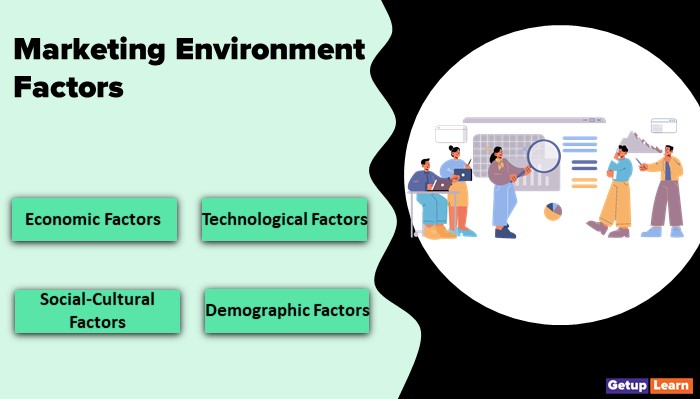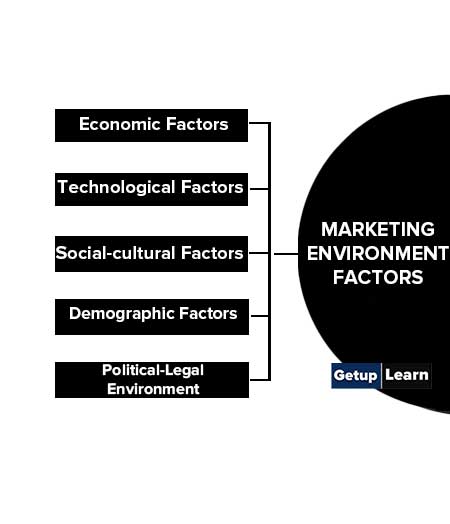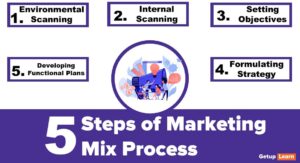Table of Contents
What is Marketing Environment?
The marketing environment is the factor that influences a company or firm’s activities. According to Kotler “Marketing environment refers to the external factors and forces that affect the company’s ability to develop and maintain a successful relationship with target customers.

The marketing environment consists of both internal and external forces. Internal forces are inherent to the firm and can be controlled by the management. In contrast, external factors cannot be controlled but are influenced by the marketing abilities of the industry as a whole rather than individual players.
The firm’s external environment is again divided into macro and micro.
Marketing Environment Factors
The marketing environment of a business consists of an internal and an external environment. The internal environment is company-specific and includes owners, workers, materials, machines, etc. The external environment is further divided into two components: micro & macro.
The micro or task environment is also specific to the business but external. It consists of factors engaged in producing, distributing, and promoting the offering. The macro or the broad environment includes larger societal forces which affect society as a whole.
Following is the broad marketing environment factors made up of six components:
- Economic Factors
- Technological Factors
- Social-cultural Factors
- Demographic Factors
- Political-Legal Environment

Economic Factors
The economic environment can have a major impact on businesses by affecting patterns of demand and supply. Companies need to keep a track of relevant economic indicators and monitor them over time.
These are the economic factors that affect the marketing environment:
Income
The income of the customer is the most important factor in the economic environment. This indicates their ability to spend on the products sold by the marketer. The marketer not only needs to estimate the income of the customer, but also he has to decipher the products on which the customer would be willing to spend his money.
Inflation
Inflation is an important economic indicator of an economy. Inflation refers to an increase in price without a corresponding rise in wages, resulting in lower purchasing power of consumers. An economy should try to achieve a low rate of inflation.
Recession
The period of economic activity when income, production, and employment tend to fall is referred to as a recession. The demand for product and services are reduced. Specific activities cause a recession. The slowdown in the high-tech sector, rising fuel prices, excessive consumer credit, and terror attacks resulted in a recession in America in 2001.
Interest Rate
If the interest rate of an economy is high, businesses will borrow capital at a higher rate and they will set up new businesses only when they are convinced that they can earn at a rate they are paying on the capital.
Therefore if the interest rates are high, new businesses will not come. Even in existing businesses operating costs would go up as their working capital requirement will attract higher interest rates.
Technological Factors
New technologies can be used very effectively to counter inflation and recession. New machines can reduce production costs. The increasing computing and processing capabilities of personal computers are increasing the efficiency and effectiveness of businesses.
Advances in Information Technologies have made it possible to plan truly global supply chains, in which manufacturing and warehousing are disbursed throughout the world depending upon where these activities can be performed at best.
Companies will be able to make better products at lesser cost and will be able to make better products at lesser costs and will be able to distribute them economically when supply chains become global.
Customers live in societies. A large part of being an individual is dependent on the society he resides in. Social factors include attitudes, values, and lifestyles of people. Social factors influence the products people buy, the prices they are willing to pay for the product, the effectiveness of specific promotions, and how, where, and when people expect to purchase products.
But societies are hardly ever static. They change gradually and some changes will be imperceptible if not watched closely. Social change is the most difficult variable for marketing managers to forecast, influence, and integrate into marketing plans.
But it is important that marketers take into account social changes happening in societies in which their customers live when they are framing their marketing strategies. Societies can change in manners that can make companies’ current products and services totally redundant.
Value
A value is a strongly held and enduring belief. The majority of people living in a society uphold the values of society. A person’s values are key determinants of what is important and not important to him, how he reacts in a particular situation, and how he behaves in social situations.
Multiple Lifestyles
Lifestyle is a mode of living, i.e. it is the way people decide to live their lives. Today people lead multiple lifestyles. They are choosing products and services that meet diverse needs and interests rather than conforming to traditional stereotypes.
Changing Structures of Families
Multiple lifestyles have evolved because people can choose from a growing number of products and services and most have the money to exercise more options. The growth of dual-income families has resulted in increased purchasing power.
More women are working outside the home and this number is only going to increase. The phenomenon of working women has a greater impact on marketing strategies and initiatives of companies than any other social change.
Demographic Factors
Demography is the study of people in terms of their age, gender, race, ethnicity, and location. Demographics are significant because people constitute markets. Demographic characteristics strongly impact buyer behavior.
The fast growth of the population accompanied by rising income means expanding markets. The longer life span means a growing market for products and services targeted at the elderly.
Political-Legal Environment
The political-Legal environment provides the legal framework within which the marketing department has to function. The political-legal environment of the country is influenced by political structures and organizations, political stability, government intervention in business, constitutional provisions affecting businesses, government attitude towards business, foreign policy, etc.
The viability of the businesses depends upon their ability to understand the laws of the land and to abide by them, while not becoming less innovative in their marketing endeavors due to fear of infringing some laws.
The stability of government is a very important factor in a company’s decision to locate its businesses in a country or a state. Businesses prefer to operate in countries where there is political stability and where the rule of law prevails.
What is marketing environment in simple words?
A company marketing environment consists of the actors and forces outside marketing that affect management’s ability to build and maintain successful relationships with the target customers. By Philip Kotler
What are the marketing environment factors?
Marketing environment factors are given below:
1. Economic Factors
2. Technological Factors
3. Social-cultural Factors
2. Demographic Factors
2. Political-Legal Environment.
What are the economic factors of marketing environment?
There are several economic factors of marketing environment like:
1. Income
2. Inflation
3. Recession
4. Interest Rate.










